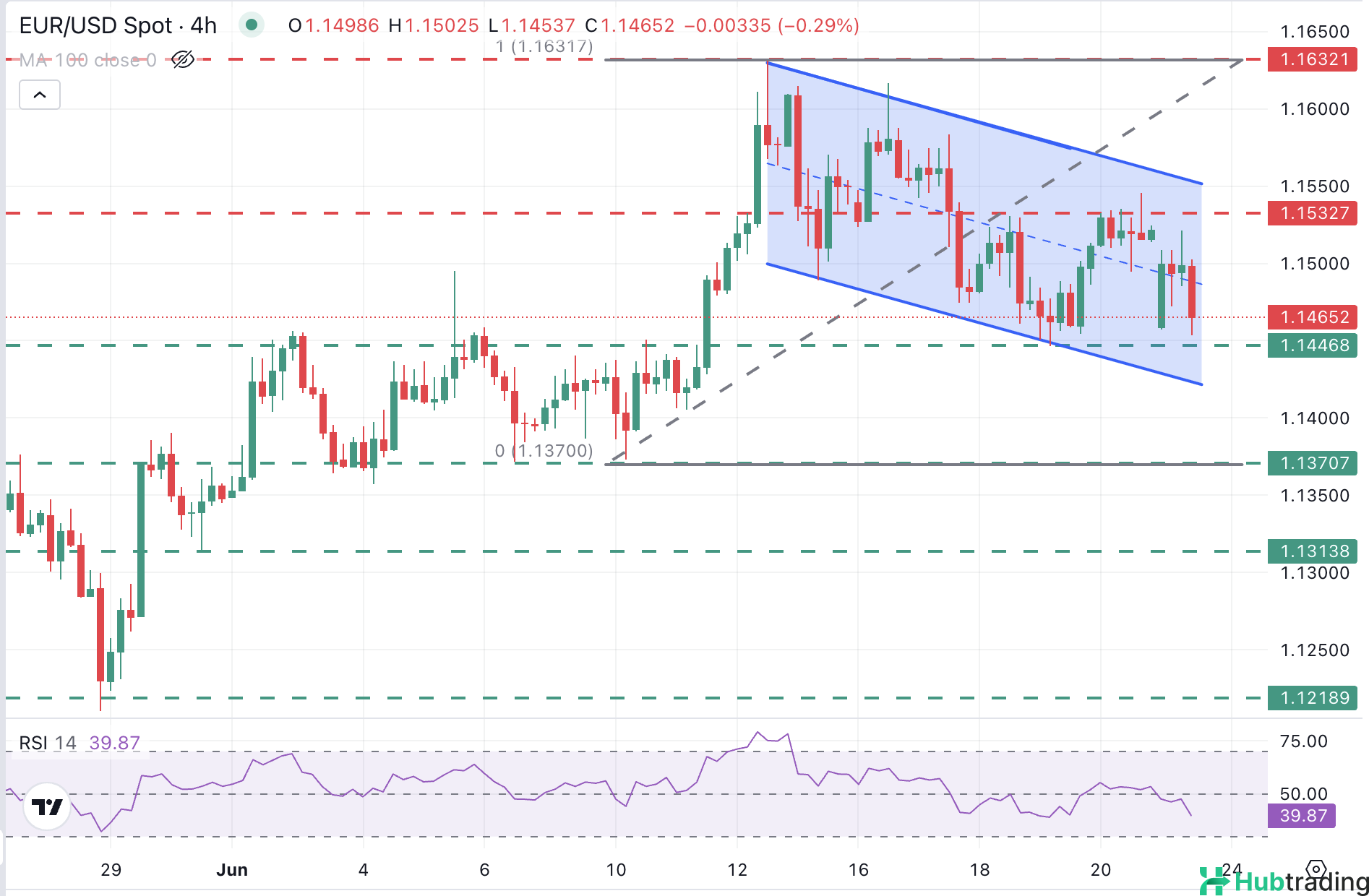EUR/USD failed to reclaim the 1.1500 level on Monday, retreating to hover just above two-week lows near 1.1450. The pair continues to trend lower within a descending channel established since the mid-June highs, as investors remain cautious amid heightened geopolitical risks and mixed economic signals.
Geopolitical tension has escalated following the U.S. airstrikes on three major nuclear sites in Iran, including the heavily fortified Fordow facility. U.S. President Donald Trump declared the strikes a significant blow to Iran’s nuclear program, characterizing them as a one-time action intended to deter further escalation—provided Tehran does not retaliate. Despite the gravity of the situation, markets have so far reacted cautiously.
Iran, however, has responded by launching missiles at Israel and approving the closure of the Strait of Hormuz, a critical chokepoint for global oil shipments. Although U.S. interests in the region have not yet been targeted, any such move could ignite a broader regional conflict and send crude oil prices soaring above $100 per barrel.
On the economic front, Eurozone HCOB PMI data showed business activity remained flat in June, disappointing expectations for a modest rebound. Market participants now await European Central Bank (ECB) President Christine Lagarde’s remarks before the European Parliament’s ECON committee for further policy insights.
In the U.S., attention shifts to the preliminary June S&P Global Manufacturing and Services PMIs, which may offer clues on the underlying strength of the U.S. economy following several weeks of weaker-than-expected data.
Daily Market Movers: Cautious Sentiment Supports US Dollar Stability as Geopolitical and Economic Uncertainty Looms
- Market sentiment remains restrained at the start of the week, as investors closely monitor escalating tensions in the Middle East. While the immediate reaction to the U.S. strike on Iranian nuclear facilities has been limited, caution prevails. Conflicting statements from former President Trump—first labeling the strike a one-time operation, then hinting at potential regime change in Iran—have only added to the uncertainty, with the broader geopolitical implications still unclear.
- The US Dollar is holding steady amid the tense backdrop, supported by safe-haven flows. Meanwhile, Eurozone assets are struggling to gain traction, as upside in the Euro (EUR/USD) remains limited by cautious risk sentiment and disappointing regional economic data. Crude Oil prices opened the week with a surge to fresh five-month highs before paring gains, yet remain up over 20% in the past month. This price rally is further straining the Eurozone economy, which is heavily reliant on energy imports.
- On the data front, the Eurozone's preliminary HCOB PMI readings for June came in below expectations. The services PMI held steady at 50.2, while the manufacturing PMI was unchanged at 49.4, both missing forecasts of 50.4 and 49.8, respectively. This reinforces concerns about stagnant growth in the region.
- Later in the day, markets will shift attention to ECB President Christine Lagarde, who is set to address the European Parliament’s ECON committee. Investors are watching for any fresh signals regarding the central bank’s monetary policy path, especially after recent hints that the ECB may be nearing its terminal rate.
- In the United States, investors await the S&P Global preliminary PMI data for June. Although modest growth is expected in both manufacturing and services sectors, any downside surprise could fuel renewed concerns over the U.S. economic outlook and put pressure on the US Dollar.
- Adding to the dovish tilt, Federal Reserve Governor Christopher Waller recently broke ranks with Chair Jerome Powell’s more hawkish stance, advocating for a July rate cut amid growing labor market risks. His remarks have heightened anticipation for Powell’s testimony before Congress on Tuesday and Wednesday, where markets will seek clues on whether the Fed could ease policy further—possibly as early as September.
EUR/USD Technical Outlook: Bearish Channel Limits Recovery from 1.1450
The EUR/USD pair has managed a mild rebound on Monday but remains confined within a descending channel from mid-June highs at 1.1630. Immediate resistance lies between 1.1535 and 1.1545, which previously capped gains on June 18 and 20. The upper boundary of the bearish channel, currently around 1.1555, reinforces this resistance zone.
A confirmed breakout above this area would suggest the ongoing correction may be forming a bullish flag, potentially shifting momentum to the upside. If confirmed, the pair could aim for the June 12 high at 1.1630, with a longer-term target at the 127.2% Fibonacci extension of the June 10–12 rally, located near 1.1700.
On the downside, immediate support is seen at 1.1445 (June 19 low), followed by stronger support along the descending trendline, currently around 1.1420. A break below these levels could extend the pair’s downward trajectory within the bearish structure.

Corrections made on June 23:
- 08:24 GMT: Added preliminary Eurozone PMI data.
-
09:42 GMT: Clarified that EUR/USD is moving within a bearish channel from June highs, not May.*





